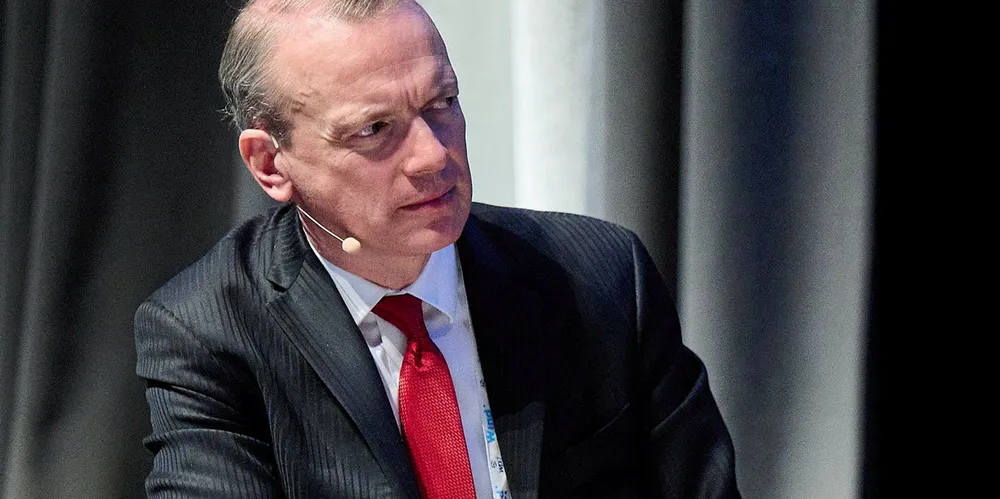'Status quo's not working' | How government red-tape is tripping up EU's wind-fuelled green plans
Kafkaesque – or just old-fashioned – permitting processes in member states are holding back wind from driving the bloc toward its ambitious energy and climate goals, says WindEurope CEO Giles Dickson

Giles Dickson, CEO of European industry advocacy group WindEurope, searches for an epitomic example. “In Italy, the photocopying costs for one onshore wind farm can be €40,000 ($45,000). It’s all done on paper. This is 2022... ,” he finally says.
Dickson, who took on the top job at WindEurope in 2015, has become all-too-familiar with the Kafkaesque bureaucracy facing those who want to build a wind farm in Italy, but nonetheless gives a brief disbelieving shake of the head.
The distinctly un-green mountain of paperwork – the digital age has not reached the process – that is needed to secure the 24 different permits from multiple Italian authorities is just one example of what WindEurope warns is part of a continent-wide wind consenting crisis that threatens to derail the EU’s entire energy transition and Green Deal.
Take what Dickson refers to as “those damned Soprintendenze” – the Italian superintendencies that have wide-ranging overview of areas of natural and cultural heritage in the country and can, according to the WindEurope CEO, step in and stop a project at any time with no right of appeal. “In Italy this happens a lot. You have the sword of Damocles hanging over you,” while developing a project, he underlines.
Procedures to prevent the Soprintendenze or their equivalents elsewhere in other bloc countries from acting on as little as a whim to scupper a well-advanced wind development is high on a list of issues WindEurope wants addressed in guidance that the European Commission is drawing up for member states on how they can simplify national permitting processes, in order to get an EU wind industry moving that is currently building at half the rate needed to meet the bloc’s ambitions.
The EU needs to be adding 30GW a year of new wind to help it hit its 40% renewable share target for 2030, but will add only 18GW annually over the next five years on current trajectories, according to WindEurope.
Quite apart from the climate imperative, Dickson says it makes no sense from an energy security point of view to be impeding a sector that can cost-effectively lessen reliance on gas from Vladimir Putin’s Russia.
Italy is not the only culprit when it comes to permitting aberrations. Dickson refers to a case in Poland, where the need to stick to the letter of original permitting resulted in manufacturer Siemens Gamesa having to dust-off disused blade moulds to equip a project with turbines that would have been fine five years earlier, but had been long superseded by more powerful and efficient technology by the time the wind farm won consent to proceed.
The freedom to use latest technology and a “common sense” approach in areas such as co-existence with aviation radar are other examples of issues on WindEurope’s wish-list for the guidance, over which it is working in detail with the Commission ahead of a planned release later in the summer. The guidance will be the important ‘how to guide’ to enable states to comply with new EU rules requiring member states to limit permitting timelines for new wind to two years at most.
In the letter WindEurope also asks the EC president to ask member states to discourage negative bidding in tenders, but conversely to encourage the use of provisions that allow up to 30% of scoring in renewables auctions to be based on non-price criteria.
The latter, says WindEurope, allows competitive processes to “reward the added value the European industry brings”.
'Supply chain in poor health'
Rewarding and supporting the European industry has arguably never been more relevant, given the fragile state of the OEM sector revealed by latest annual results that show all but one major player in Europe loss-making – the exception being Dane Vestas, though that company was only narrowly profitable.
Dickson and WindEurope say the root of the problem is volume – OEMs and the developers they supply competing for a slice of a cake that is half the size it should be, driving down bidding in auctions and cutting margins to the bone or beyond at a time when there is no end in sight to the supply chain issues and commodity inflation that are piling pressure on industrial companies.
“The status quo is clearly not working at the moment, because we don’t have a supply chain in good health, that’s performing in a normal, healthy, viable manner.”
Could it be that there are just too many OEMs? “That is not the issue,” Dickson insists. “The issue is the volumes in the markets, high commodity prices, high steel prices.”
The WindEurope chief also warned the EU that if its own wind supply chain implodes, there are others that could take its place, pointing out that Chinese manufacturers are already supplying projects on the continent both on and offshore.
“This is happening already – admittedly still very small scale, but it’s started.”
(Copyright)